Trypan blue aids in the management of mature cataracts
Performing the capsulorrhexis is one of the biggest problems facing a phaco surgeon in this situation.
 One
of the biggest problems for a phaco surgeon facing a mature or hypermature
cataract is performing the capsulorrhexis. If the rhexis is incomplete, one
might have to convert to extracapsular cataract extraction to prevent posterior
capsular rupture or nucleus drop.
One
of the biggest problems for a phaco surgeon facing a mature or hypermature
cataract is performing the capsulorrhexis. If the rhexis is incomplete, one
might have to convert to extracapsular cataract extraction to prevent posterior
capsular rupture or nucleus drop.
One solution to this problem is to use a dye to stain the anterior capsule. Trypan blue is marketed as VisionBlue by DORC International (Zuidland, Netherlands). Each milliliter of VisionBlue contains 0.6 mg trypan blue, 1.9 mg of sodium mono-hydrogen orthophosphate, 0.3 mg of sodium dihydrogen orthophosphate, 8.2 mg of sodium chloride and sodium hydroxide for adjusting the pH and water for injection.
Applying the dye
 We
prefer a temporal clear corneal incision. If astigmatism is plus at 90°,
the incision is made superiorly. Viscoelastic is injected into the eye in the
area where the second site is to be made. A straight rod is used to stabilize
the eye with the left hand. With the right hand, the clear corneal incision is
made.
We
prefer a temporal clear corneal incision. If astigmatism is plus at 90°,
the incision is made superiorly. Viscoelastic is injected into the eye in the
area where the second site is to be made. A straight rod is used to stabilize
the eye with the left hand. With the right hand, the clear corneal incision is
made.
Air is injected into the anterior chamber to prevent dilution of the trypan blue. The trypan blue is injected through a cannula into the anterior chamber between the air bubble and the lens capsule. It is kept like that for a minute or two as staining of the anterior capsule occurs. Viscoelastic is then injected into the chamber to remove the air bubble and the trypan blue.
Capsulorrhexis is begun with a needle. We prefer a needle, as it gives better control of the size of the rhexis. The left hand holds a rod stabilizing the eye while the rhexis is performed. As the rhexis is continued, the contrast between the stained capsule and the unstained cortex is noted.
Hydrodissection is then performed. One will not be able to see the fluid wave in such cases, as the cataract is very dense. In such cases, a simple method is to see if the lens comes up anteriorly a little bit. This will indicate that hydrodissection is completed. One can test this by rotating the nucleus.
The phaco probe is inserted through the incision slightly superior to the center of the nucleus. Ultrasound is applied and the phaco tip is embedded in the nucleus. The probe should be directed obliquely downward toward the vitreous, not horizontally toward the iris. This way, the nucleus will be embedded.
Settings at this stage are 80% phaco power, 24 mL/min flow rate and 101 mm Hg suction. By the time the phaco tip is embedded, the tip will have reached the middle of the nucleus. With the chopper, the nucleus is cut with a straight downward motion. The chopper is moved to the left when it reaches the center of the nucleus. In other words, the left hand moves the chopper like an inverted L. Chopping is done at the center, not the periphery. Once the crack is created, the nucleus is split to the center. Then the nucleus is rotated 180° and cracked again so that we get two halves.
Now that we have two halves, we have a shelf on which to embed the probe. We place the probe with ultrasound into one half of the nucleus and chop. We create three segments in one half of the nucleus, then we make another three segments in the other half. We now have six pie-shaped fragments.
Once all the pieces have been chopped, we take each piece one by one, and in pulse mode, aspirate the pieces at the level of the iris. We do not work in the bag unless the cornea is bad preoperatively or the patient is very elderly.
The next step is cortical cleaning. We always try to remove subincisional cortex first, as that is the most difficult. At all times, the left hand has the straight rod controlling the movement of the eye. If necessary, we use bimanual irrigation and aspiration. We then inject viscoelastic and implant the IOL.
Cautions exist
 One is still not sure whether extended
contact of trypan blue with the endothelium produces corneal damage. No such
complications have been reported. The trypan blue is washed off with
viscoelastic and saline fluid.
One is still not sure whether extended
contact of trypan blue with the endothelium produces corneal damage. No such
complications have been reported. The trypan blue is washed off with
viscoelastic and saline fluid.
Postop inflammatory reactions and bullous keratopathy have been known to occur after use of vital staining agents. Care must be taken when using trypan blue on patients hypersensitive to any of its components.
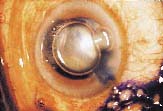 |
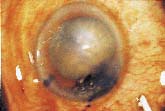 |
| Air is injected and trypan blue dye is injected between the air bubble and the anterior lens capsule. | Viscoelastic is injected to remove the air bubble and the trypan blue. |
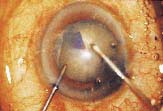 |
 |
| Capsulorrhexis is started with the needle. Note the straight rod in the left hand to stabilize the eye. | Rhexis is continued. Note the contrast between the stained anterior capsule and the unstained cortex. |
 |
 |
| Hydrodissection is performed. | The phaco probe is embedded in the nucleus. |
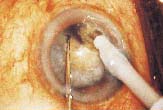 |
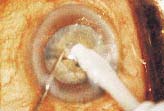 |
| The two halves of the nucleus are split. | The probe is embedded horizontally, not vertically, in one-half of the nucleus. |
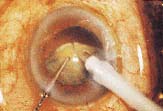 |
|
| The final bits of nucleus are removed. |
For Your Information:
- For information on VisionBlue, contact DORC International BV, Scheijdelveweg 2, 3212 VN Zuidland, Netherlands; +(31) 181-458080; fax: +(31).181-458090; web: www.dorc.nl.
- Amar Agarwal, FRCS, FRCOphth(Lon), Sunita Agarwal, FSVH(Germ), DO, and Athiya Agarwal, MD, FRSH(Lon), DO, can be reached at Dr. Agarwal’s Eye Hospital, 13 Cathedral Road, Chennai – 600 086, India; +(91) 44-8273704; fax: +(91) 44-8265871; e-mail: agarwal@gisamd01.vsnl.net.in. The Drs. Agarwal have no direct financial interest in any of the products mentioned in this article, nor are they paid consultants for any companies mentioned.
